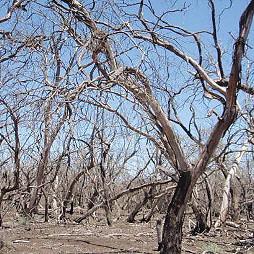Posted 26 February 2009

Ancient red gums are casualties of central NSW wetlands in severe decline: report
Ancient red river gums are dying in vast numbers due to water diversions from the Lachlan River in central NSW, according to a new report. It reveals 85 percent mortality over the past 12 years among Eucalyptus camaldulensis within a large delta of the 15,000-hectare Booligal Wetlands.
UNSW researchers investigated more than century of rainfall patterns and hydrological changes to the river as well as changes to the supply of water to the river red gum swamp communities within the Booligal Wetlands and the resulting impacts of the changes. Also, they analysed a sequence of aerial photographs, spanning 35 years (1973-2008) to determine trends in river red gum health, backed up with on-the-ground assessments.
They found no long-term decline in catchment rainfall where most flows for the Booligal Swamps are generated. However, they noted significant declines in the Lachlan's flow that have profoundly affected the ecology of the Booligal red gum swamps - changes that have coincided with increasing impacts of major river regulation and diversion of water for irrigation.
The wetlands are a nationally important region recognised for sustaining large water-bird colonies. They form a part of the extensive lower Lachlan river wetlands and rely on river flows from the upper Lachlan, with the tributaries of the Belabula and Abercrombie Rivers.
The Lachlan catchment covers 85,000 square kilometres, extending westwards from the Great Dividing Range to the Riverina. It has an estimated population of greater than 100,000, and produces 14 percent of the state's agricultural production.
Within the catchment, there are 10 large dams and 323 weirs, and an extensive system of canals, regulators, pumps and off-river storages that allow for the diversion of water from the river. In the past 100 years, these have allowed water diversions from the river, decreasing flows to the Booligal wetlands by 50 percent, affecting essential large flows to the wetlands.
The red river gum is a long-lived species, living up to hundreds of years. According to the report, it has survived long periods of drought in Australia's history but the impacts of river regulation and diversion, and the current drought, have caused very high mortality of river red gums all along the rivers of the Murray-Darling Basin.
The devastation of the gum species is the most obvious and measureable effect of ecological decline, although water-birds, fish, frogs, reptiles, invertebrates and plants are likely to be affected by water restrictions to this sensitive area, says the report by researchers at the UNSW Australian Wetlands and Rivers Lab. The finding echoes several other reports noting the decline in the health of red river gums along the River Murray, the Lowbidgee floodplain on the Murrumbidgee River, and in the Macquarie Marshes.
The key impacts of dam building and water diversions are as follows:
Commenting on the findings, the report's co-author, Richard Kingsford says, "We hadn't really realised the full impacts of diverting water and the drought on the nationally listed Booligal wetlands until now. We now know that this river too is in poor ecological shape and its other nationally important wetland area, the Great Cumbung Swamp is also being affected by lack of water."
"This decline accelerated in the last three years, and without significant improvement of river flows to these wetlands, the chances of rehabilitation will be poor," says Professor Kingsford.
One estimate indicates that 50 percent of Australian wetlands have been lost since European settlement. In highly populated areas this figure is put as high as 90 percent
The report's lead author, Jessica Armstrong observes, "These wetlands are now like graveyards. The red gums are like silent dead sentinels in what was once a remarkably productive ecosystem, brimming with biodiversity. We just don't know how much all of the other plants and animals rely on the red gums".
The Booligal Wetlands join a growing list of nationally important wetlands that are in severe decline, according to the report, which says the chances of rehabilitating these wetlands are slim although investment by governments in the buyback of water from irrigation licenses offers some opportunity for rehabilitation.
The effect of regulating the Lachlan River on the Booligal Wetlands - floodplain river red gum swamps. February 2009: Jessica L. Armstrong, Richard T. Kingsford and Kim M. Jenkins. Wetlands & Rivers, School of Earth & Environmental Sciences, University of New South Wales. The report was funded by the University of New South Wales and supported by NSW Department of Environment and Climate Change.
Media contacts:
Richard Kingsford - 0419 634 215
Dan Gaffney - UNSW Science Media, 0411 156 015
Links:

Professor Andy Baker features in American Water Resources Association ‘Water Resources Impact’, September 2020 edition.

The Connected Waters Initiative (CWI) is pleased to welcome Taylor Coyne to its network as a postgraduate researcher. If you’re engaged in research at a postgraduate level, and you’re interested in joining the CWI network, get in touch! The CWI network includes multidisciplinary researchers across the Schools of Engineering, Sciences, Humanities and Languages and Law.

The Grand Challenge on Rapid Urbanisation will establish Think Deep Australia, led by Dr Marilu Melo Zurita, to explore how we can use our urban underground spaces for community benefit.

On the 21 August 2020, CWI researchers made a submission to the National Water Reform Inquiry, identifying priority areas and making a number of recommendations as to how to achieve a sustainable groundwater future for Australia.

Results published from a research project between the Land Development Department (LDD) Thailand and UNSW has demonstrated how 2-dimensional mapping can be used to understand soil salinity adjacent to a earthen canal in north east Thailand (Khongnawang et al. 2020).